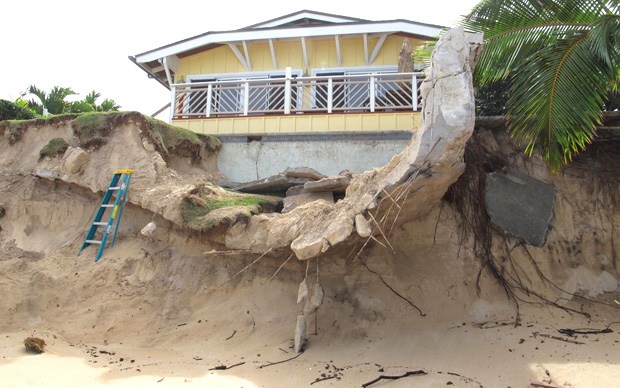HALEIWA, Hawaii (KHON2) — As the winter surf season begins, so do discussions about the future of Oʻahu’s eroding North Shore.
For the first time, community members, beachfront homeowners, engineers, and the University of Hawaiʻi Sea Grant gathered Saturday to discuss what the future looks like for portions of the island’s world-famous “Seven Mile Miracle.”
It’s a topic that’s become increasingly urgent.
In 2022 a home collapsed into the ocean near Rocky Point and then in October 2024, a home located a few houses down was forced to be demolished after it started crumbling into the ocean.
The lot is now for sale but the listing states a home might not be able to be built on the lot due to the severe erosion and to check with DPP. However, experts warn it won’t be the last house to fall into the ocean and they’re trying to find solutions to prevent that from happening.
With a $1 million grant, the University of Hawaii Sea Grant and the North Shore community are working on a North Shore Beach Management Plan which is aimed at identifying short and long-term community-supported solutions to protect the coastline.
The plan focuses on three areas: Shark’s Cove to Rock Pile, Rock Pile to Rocky Point, and Rocky Point to Sunset.
“We’re asking some very specific questions about different types of beach management strategies and what the community might favor,” said Dolan Eversole, Coastal Processes Specialist with Hawaiʻi Sea Grant. “Things like sand management versus doing more structural measures and armory.”
Eversole said the plan combines science and community input, starting with addressing practical, low-cost steps.
“The low-hanging fruit, as we say, is sand management,” he added. “That includes dune restoration and better public infrastructure to control erosion.”
Further down the road, the plan could explore more complex structural or land-use measures, such as stabilizing beaches with limited structures if needed.
Many longtime homeowners say they’re frustrated by the lack of support over the years. Most of the beachfront homes along the North Shore were built in the 1960s — before the state banned sand mining. At the time, shoreline revetments were also allowed, but they no longer are.
“Shoreline hardening is technically not allowed by Act 16,” explained Andy Wycklendt, a coastal engineer with Integral Consulting. “Any sandy beach that’s around — you can’t put hardened structures on the shoreline.”
Wycklendt said that’s to ensure beaches remain public trust resources and not lost to erosion. His team will be collecting LiDAR data before and after large wave events to better understand how sand moves along the shoreline.
“We collect our first series of data this week,” he said, “and we’ll collect additional data in about a week or two after the first major swell.”
There will be two more community meetings over the next year as the plan develops. The final North Shore Beach Management Plan is expected to be completed by late 2026, with recommendations for state lawmakers.
